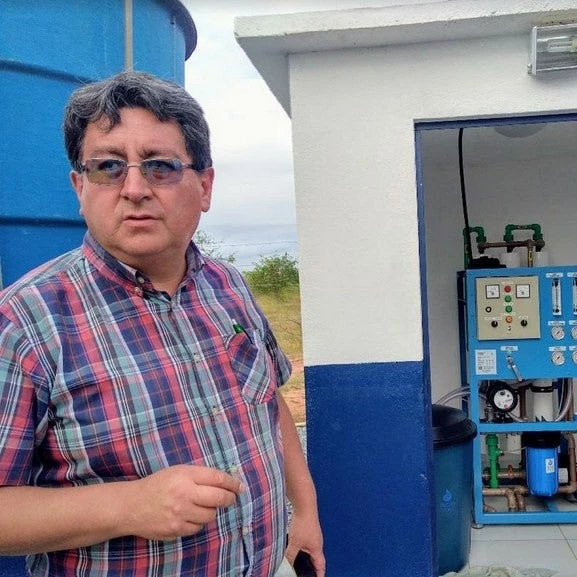 Bolivia waste to resource
Bolivia waste to resource
Also available in: Español
Editor’s Note: Efficiently investing in wastewater and other sanitation infrastructure is crucial to achieve public health benefits, improve the environment, and enhance quality of life. Safely managed water, sanitation and hygiene (WASH) services are an essential part of preventing disease and protecting human health during infectious disease outbreaks, including the current COVID-19 pandemic. Learn more: www.worldbank.org/wastetoresource
In the last two decades, Bolivia has made good progress in improving access to water supply and sanitation (WSS) services. Yet, even though access to piped water and wastewater collection has increased, the quality of those services is still not optimal, especially for the poorer population. Service interruptions and sewer blockages are common. The quality of water and wastewater service delivery also remains a challenge, especially in areas facing water scarcity.
In Bolivia, it is estimated that only 27 percent of wastewater is treated (WSP, 2016). In cities with over 10,000 residents, the wastewater treatment rate is only 39 percent. Wastewater treatment facilities in cities like El Alto, Oruro, Cochabamba and Tarija need to be upgraded and expanded; whereas the capital city La Paz, with nearly 800,000 inhabitants, does not even have treatment facilities. Instead, untreated wastewater is discharged into the Choqueyapu and La Paz Rivers – further increasing water pollution and putting human health at risk.
Urban expansion has significantly increased domestic and industrial water demand in Bolivia, and untreated wastewater is frequently reused for irrigation in water-scarce areas. Polluted water downstream of the La Paz River is used for irrigation with no restrictions. But its informal use, due to a lack of regulation, poses potential risks to the health of urban consumers of agricultural products as well as the health of farmers and their families.
To tackle these challenges, the Ministry of Environment and Water (Ministerio de Medio Ambiente y Agua - MMAyA) started in 2017 to develop a National Strategy for Wastewater Management and Reuse, which aims to both address water pollution and public health issues caused by low levels of wastewater treatment and unregulated use in agriculture, and to promote reuse within the broader concept of a circular economy. The Global Water Security & Sanitation Partnership (GWSP), a multi-donor trust fund housed within the World Bank’s Water Global Practice, has been providing technical assistance to the formulation of the Strategy.
To achieve these goals, specifically in La Paz, the construction of a wastewater treatment plant is urgently needed, as well as a network of trunk sewers and emissaries to transport the wastewater to the treatment plant itself.
But building a new facility is just the beginning. To ensure the sustainability and effectiveness of the new La Paz wastewater management system, operation and maintenance plans need to be developed and robustly implemented. Support also needs to go to: (i) strengthening the policy, institutional, regulatory and financing frameworks regarding wastewater management; (ii) increasing public awareness regarding the importance of and the costs associated with wastewater treatment; (ii) promoting environmental recuperation of the watercourses located in the Choqueyapu and La Paz rivers’ watersheds to reduce public health risks and create green areas in La Paz city; and (v) enhancing resource recovery from wastewater treatment to promote water and biosolids reuse for agriculture and land restoration.
To close the gap on sanitation in Bolivia, it also needs to go beyond conventional wastewater collection and treatment solutions and consider non-conventional sanitation arrangements, including off-sewage network solutions and fecal sludge management, among others.
Our experience in supporting wastewater management – both region-specific and global – also reveals important lessons, including:
- The choice of wastewater technologies should be based on full life-cycle costs (i.e., investment costs, and operation and maintenance costs).
- The positive social implications of the facilities should be considered over the entire cycle: jobs generated by the construction, operation, and maintenance of the plant; increases in property values following the improvement of the receiving water body; alternative water sources for farmers from reuse; and improved health from better water quality.
- The importance of ensuring that utilities have adequate capacity to operate and maintain wastewater treatment. Relatedly, the need to ensure that utilities generate enough revenues to pay for operation and maintenance costs.
The WSS sector in Bolivia consists of a few institutions. For example, MMAyA, its Vice-Ministry of Drinking Water and Sanitation (Viceministerio de Agua Potable y Saneamiento Basico - VAPSB) and the Vice-Ministry of Water Resources and Irrigation (Viceministerio de Recursos Hídricos y Riego), are the sector authorities responsible for water and wastewater policies, technical standards and norms, and budgeting for sector investments when these are prioritized by the central government. The provision of WSS services, on the other hand, is the responsibility of municipal governments. Municipalities can provide these services directly or through entities providing basic water and sewerage services (Entidades Prestadoras de Servicios Basicos de Agua y Alcantarillado, EPSAS), which in urban areas normally adopt the structure of municipal or service cooperatives. In this sense, cross-sectoral and multi-stakeholder collaboration is also key to the success of Bolivia’s wastewater strategy. To achieve that, the national and municipal governments, as well as the water utility, with support from the World Bank and other development partners, are working together to incorporate circular economy principles in the design of the La Paz wastewater treatment plant.
Wastewater can be a valuable resource if the right policies, technologies and financial incentives are in place. The World Bank stands ready to support Bolivia in increasing wastewater treatment and reuse coverage rates to ultimately reduce water pollution and achieve environmental recuperation, improve the health of populations and contribute to building climate resilience in agricultural areas surrounding urban cities.


Join the Conversation